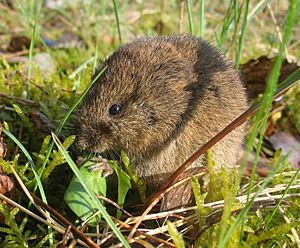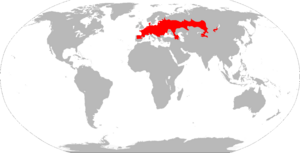Common vole facts for kids
Quick facts for kids Common vole |
|
|---|---|
 |
|
| Conservation status | |
| Scientific classification | |
| Genus: |
Microtus
|
| Species: |
arvalis
|
 |
|
| Common vole distribution | |
| Synonyms | |
|
Microtus obscurus (Eversmann, 1841) |
|
The common vole (scientific name: Microtus arvalis) is a small rodent that lives across Europe. It is often called a field mouse, but it is actually a type of vole. These tiny creatures are very common in many parts of the world. They play an important role in their habitats.
Contents
Where Common Voles Live
Common voles can be found in many places across Eurasia. However, they do not live in the British Isles, except for a special type called the Orkney vole. These voles are very good at adapting to different environments. This means they can live in many kinds of places.
Natural Homes for Voles
Common voles naturally live in open areas. These include meadows, grassy fields, and heath lands. They also like areas where land is left unused, called fallow land. They usually avoid dense forests.
Voles and Farmland
Common voles have also adapted to live near humans. They often make their homes in farm fields. They prefer areas with gentle slopes. Their main food is grass. But they also eat many farm crops. When they live on farms, they can have babies more quickly than in their natural homes.
How Common Voles Live and Grow
Common voles have a short but busy life. They are an important food source for many other animals.
Having Babies
Female voles are pregnant for about 16 to 24 days. They usually give birth to 3 to 8 tiny babies. Each baby weighs between 1.0 and 3.1 grams. The babies drink their mother's milk until they are about 20 days old.
Young female voles can have their own babies very early. They can become pregnant as early as 13 days after birth. This means they can give birth for the first time when they are only about 33 days old. Female voles usually have three groups of babies each year. This happens between March and October.
Lifespan and Population
Most common voles live for about 4.5 months. This means many of them die after their last babies are born in October. The babies born late in the year often survive the winter. They then start having their own babies the next spring.
Adult male voles can weigh up to 51 grams. Females who are not pregnant usually weigh up to 42 grams. When babies are born, there are usually equal numbers of males and females. But as they grow, there can be more females. Sometimes, there can be three or even four females for every male.
The number of voles in an area changes a lot. This happens with the seasons. It also changes over longer periods, often in three or five-year cycles. There can be as few as 100 voles in a hectare (about 2.5 acres). In some years, there can be as many as 2000 voles in the same area. When there are too many voles, females might have fewer babies. This helps control the population size. The amount and quality of food and light also affect how many babies they have.
Who Eats Voles?
Common voles are a main food source for many predators. These are animals that hunt and eat other animals. In Central Europe, many birds hunt voles. These include Buzzards, kestrels, long-eared owls, tawny owls, and barn owls.
Animals that hunt on the ground also eat voles. These include weasels, stoats, adders (a type of snake), polecats, foxes, and boars. These predators help keep the vole population in balance.
Vole Homes and Spaces
Common voles create special paths above ground. These paths are like a tiny railway system. They spread out all over the vole's home area. Voles usually stay on these paths. The paths help them move faster and stay safe. They also help the voles find their way around. Common voles are not very good at climbing.
Underground Nests
Voles dig nests deep underground. These nests are usually about 30 to 40 centimeters (12 to 16 inches) deep. They use these nests for several things. They store food there. They also raise their babies in the nests. And of course, they use them for resting and sleeping.
Sometimes, up to five female voles might share a nest. They often share with their relatives. Female voles are very protective of their space. They do not let other females overlap their territories. This means that as more voles live in an area, more separate nests and colonies are formed.
Male Vole Movement
Male voles do not usually have their own fixed territories like females. Instead, they move around between the territories of several females. They are sometimes called "floaters." This allows them to find as many mates as possible. Their home areas are much larger than females'. Males might use an area of 1200 to 1500 square meters. Females usually use 300 to 400 square meters. When there are many voles in an area, both male and female territories can become smaller.
Sometimes, voles will leave their home area and move to a new one. This often happens when the population grows too large. Males are more likely to move away. They often do this because they are competing with other males for mates.
See also
 In Spanish: Topillo campesino para niños
In Spanish: Topillo campesino para niños


